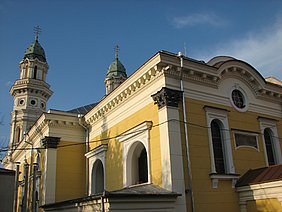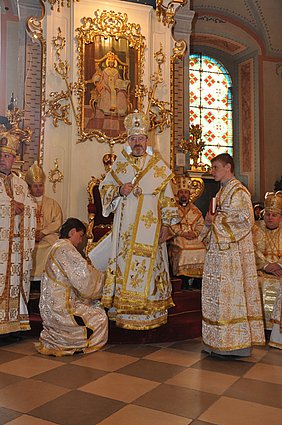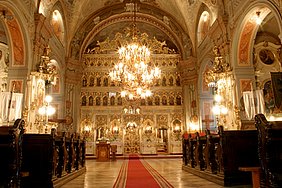The Greek-Catholic Eparchy (Ruthene-Catholic Church) of Mukachevo in Transcarpathia – history and future
This is to present the Eparchy of Mukachevo in Transcarpathia region, Republic of Ukraine. The Greek-Catholic Eparchy of Mukachevo, also Ruthene-Catholic Church, has its roots in the Union of Uzhgorod, which took place in 1646. In the north-east part of the Austro-Hungarian Empire the Catholics were called ruthenians or the Ruthenian Church. In 1771 during the rule of the Austro-Hungarian Empress Maria Theresia the Eparchy of Mukachevo was officially recognized and was introduced to call the faithful as the Greek-Catholics and the Church as Greek-catholic. The Eparchy is located in the region of Transcarpathia. There are 1.248.000 inhabitants, and 320.000 of them are Greek-Catholics resp. Ruthene-Catholics (ca. 25% of the regional population). Besides that, in the Region live 60.000 Roman-Catholics.
The Church was strongly persecuted after the Second World War. On the 1st November 1947 Bishop Theodor Romza was assassinated, now already beatificated. At the beginning of 1949 started persecution against the Greek-catholic Church, and thus the Church was underground for 41 years. The Church hierarchs were annihilated, 128 priests were put in the prisons or sent to exile to Siberia for many years, and 20 of them never returned back. Some of them were assassinated there. Altogether the church has 36 priests-martyrs. In December 1989 the Church officially revived from underground and since then it freely confesses and practices tradition and rite. The Ukrainian government rehabilitated all the priests.
His Beatitude Eparch Mons. Milan Sasik CM
There are 415 communities officially registered by the government. From the 440 churches and 6 monasteries registered by 1949 came back only 127 churches and 3 monasteries (40 were destroyed by communists). In some villages both Orthodox and Greek Catholics use the same church according to the fixed schedule. There are 14 villages in which the church buildings are used in turns. In 1991 the government assigned for the property of the Orthodox Church 260 of the old churches, which were owned by the church till 1949. In 17 cases church services are made in common churches with the roman-Catholics. Many communities celebrate in same buildings.
Since 1990 there have been built in Mukachevo Eparchy 150 churches and chapels new. Another 60 churches are in the process of construction. Besides that 30 more new churches and chapels are planned to be built.
At present there are 63 rectories (parish houses) ready. 25 rectories are in the process of construction and another 22 – in the process of reconstruction (altogether 110 rectories). Yet 80 rectories have to be built in order to ensure a full value pastoral care in all the parishes, and to ensure that Mukachevo Eparchy needs altogether 190 rectories. To build one of such churches from brick costs from 70.000 to 130.000 Euros. The wooden church may costs about 45.000 Euros. Before 1949 the church counted more than 500 buildings of real estate (rectories, schools, educative houses...). Some of the old property was given for the property of different institutions, and that will never be returned. At this moment the church has 220 eparchial priests, 23 religious, and 9 emeritus.
History, significance and general description of the Episcopal Residence.
The history of the Episcopal residence is closely tied with the history of our Cathedral dedicated to the Feast of the Exaltation of the Holy and Glorious Cross, which is located right next on the same street – Kapitulna 11. Its foundation was laid in 1641. At that time there were Jesuit collegium and school – the first middle educational institution in Uzhgorod and Transcarpathia region. According to the foundational charter of the Jan X Druget collegium had 21 cell for Jesuit monks, rooms for teachers, chapel, library, study classrooms, large lecture-hall for discussions and theatre performances, room for the sick, pharmacy, basement, storage rooms, kitchen. The monks lived on the second floor while school was located on the first floor. In 1773 the collegium was given to the State and for a while it was not used, while school continued to function. On August 1, 1775 Austro-Hungarian Empress Maria-Theresia donated the Jesuit building into the disposition of the Greek-Catholic Eparchy of Mukachevo. Necessary documents were signed in the rector’s room of the collegium in the presence of the Bishop Andrew Bachinskij, canons and the members of the regional commission. It included also school and library. In the summer 1785 the building of the school was demolished. Later on in times of the Bishop July Fircak there was organized beautiful little garden, which still adorns the entrance into the Residence.
Bishop Andrew Bachinskij partly renovated and rearranged Jesuit collegium as fitted for the Episcopal residence. Later on, in 1846, Bishop Vasyl Popovich reconstructed it, giving the building modern outlook. On the upper part of the Residence facade were fixed four emblems. One in the centre belongs to Bishop Andrew Bachinskij, those on the sides – to the bishops Vasyl Popovich and Stepan Pankovich, while the emblem located directly over the main Residence entrance, belongs to the Bishop July Fircak, which similarly as his forerunners considered as a duty to perfect the overall structure of this baroque with classical elements architectural pearl.
Episcopal residence amazed not only with its outlook and vivid location, but also with its interior. Let’s begin our little excursion from the Residence ground floor on the western part of the steep hill. Here in three big rooms was located large and very rich library. The first mention of the Episcopal library is related to 1767. Before the First World War the library contained more than 20 000 books. In Soviet times the library was confiscated and given in the disposition of the Uzhgorod State University. Partly this unique book collection escaped destruction; moreover it is still in the same rooms as was in times of the Bishop July Firtsak. On the first floor one can get through the main entrance. There were located rooms for guests, steward, consistorial secretary, other service personal and four rooms for the Bishop’s apartment. Second floor was undoubtedly the richest and most interesting part of the Residence. One can get there by the wide central stairs or inner – narrow metal stairs from the Episcopal apartment. First to what should be paid attention is Episcopal private chapel. About the Jesuit collegium’s chapel was already mentioned in foundation charter of Jan X Druget. In 1777 on the feast of Assumption of Our Lady in the chapel reconstructed by Bishop Andrey Bachinskiy, was celebrated first Divine Liturgy. Bishop used the chapel on Sundays and feast days. There also took place ordination to priesthood. In order to get to the chapel one have to cross a large hall – refectory. Next to refectory was “pinky salon”. There on the walls hanged pictures of the Austrian Emperors and Hungarian Kings, picture of the pope Pius X. But in 1905 there was mounted a memorial plate to remind us that in the night from 9 to 10 of December 1805 and then from 11 to 12 of March 1806 in this room was preserved holy crown of Hungarian kings in times of Napoleon Wars. Impresses by its beauty and richness also “red salon”. It was furnished with elegant and very expensive furniture and with many original hand-works of the famous Hungarian and German painters. Next to the “red salon” was piano room, where Bishop Fircak used to spend his leisure. From salons we get into the archducal apartments, that had two bedrooms and smoking-room, arranged in one of the Residence towers. H.I.R.H. Austrian archduke Joseph stayed here during his visits to Uzhgorod. On the second floor there were also bedroom of Bishop Popovich, billiard-room, but in Residence northern part – Episcopal offices, workrooms.
Episcopal residence during all the stages of its long history was not only Bishop’s dwelling place. Here took place important ecclesiastical meetings, secret negotiations, meals for the poor, ordination of the new candidates to priesthood and silent prayers of our diocesan rulers.
Right before the liquidation of the Greek-Catholic Church in Transcarpathia, on February 16, 1949 Episcopal residence was occupied by Soviet militia, so diocesan administrator Mikola Muranij (1911-1979) was forced to give them the key. In 1950 Episcopal residence was given in the disposition to the Uzhgorod University library, which till the present day occupies part of the Residence (mainly book storages).
In 1989 Greek-Catholic Eparchy was legalized. In 1990 the State officially restored the building of the Cathedral to the property of the Greek-Catholic Eparchy of Mukachevo. Nevertheless, the actual return of our Cathedral happened only after a few years of stubborn fights on October 10, 1991. Last reparation works of the Residence were accomplished before 1940. Thus, for more than 70 years there were no repairs or renovation works. The official process of returning stage by stage the Episcopal Residence started only in 2004. Already there have been returned seven rooms and the chapel (240m2 out of near 3000m2).
In May 2009 the building of Episcopal Residence was officially registered as a property of Mukachevo Greek Catholic Eparchy. On 24th of April 2010 Bishop Milan Sasik CM solemnly consecrated partly renovated attic floor of the Episcopal Residence. There was completed 750 m2 out of 1104 m2 of the attic floor area. There still remains to complete 354 m2 of the attic floor area. At present all essential eparchy administration offices temporarily occupy the rooms of the attic floor until the complete renovation is finished of the first and second floor of the Residence. Also, there was started a process of transference of the State University Library from the Residence to the Uzhgorod University building. Recently second floor of the Residence is vacated.
In May 2009 the building of Episcopal Residence was officially registered as a property of Mukachevo Greek Catholic Eparchy.
For any inquiries or further information subject the Greek-Catholic Eparchy of Mukachevo (Ruthene-Catholic Church) please contact: eparchygc@utel.net.ua
Webpage: www.mgce.uz.ua
Timetable: THE MUKACHEVO GREEK CATHOLIC EPARCHY
1640 – Count John Drugeth X donated the land in Uzhgorod to the Society of Jesus. On August 31, 1640 construction of the Jesuit College, school and church began. Construction continued from 1640-1644 under the direction of the rector Győrgy Dobronoky.
1644 – The college building was damaged by the troops of Győrgy Rákoczy I.
1646 – Countess Anna Jakušić, widow of John Drugeth X, renovated the college and it began to function.
1732-1740 – Jesuits constructed a new church (present cathedral) with two towers in the late baroque style on the site of the old church.
1771 – Canonization of the Mukachevo Greek Catholic Eparchy.
1772 – Bishop Andrej Bachynskyj (1772-1809) was enthroned as bishop: an outstanding religious and cultural era.
1773 – The Jesuit Order in Uzhgorod was suppressed. The college was transferred to the possession of the Austrian crown.
1775 March 1 – Austro-Hungarian Empress Maria Theresia transferred the college and church to the Mukachevo Greek Catholic Eparchy to be used as the Bishop’s residence and cathedral.
1779 – The iconostasis was installed under the direction of Francis Fech. The icons were painted by the Basilian monk Tadej Spalinskij.
1780 October 15 – Bishop Andrej Bachynskyj dedicated the cathedral. Since that time the former Uzhgorod Jesuit College has been the residence of the Mukachevo bishops. To commemorate this event a marble plaque deeding these buildings to the eparchy by Austro-Hungarian Empress Maria Theresia was placed in the sanctuary.
1846 – Bishop Vasyl Popovych (1836-1864) completed the construction of the residence at his expense. The building was made into three-stories with twp octagonal towers. A new bishop’s chapel was arranged. Gregory Reves painted the ornamental murals and altar icons.
1858 – The eparchial painter Ferdinand Vidra (1815-1879) executed the mural painting in the cathedral.
1876-1878 – Under the Bishop Ioann Pastelij (1874-1879) a portico with four Corinthian capitals was added to the western façade of the cathedral and the second tier of the towers was reconstructed into an octagonal form. Lucas Fabri drew the architectural plans. At the very beginning of the 20th century – under Bishop Yulij Firtsak (1891-1914) the shape of the tops of the residence towers was changed from low semispherical to higher helmeted form.
1927 – Under Bishop Petro Gebej (1924-1931), artist Josyp Bokshaj (1891-1975) executed the mural painting in the bishops chapel and renovated them in 1942 under Bishop Alexander Stojka (1932-1943).
1938 – A majestic composition “Exaltation of the Holy Cross” was painted by Josyp Bokshaj in the cathedral vault.
1772-1947 – A total of 70 outstanding church personalities were buried in the cathedral cript: among them bishops Ioann Bradach, Andrej Bachynskyj, Oleksij Povchij, Vasyl Popovych, Stephan Pankovych, Yurij Firtsak.
1947 October 31 – Theodore Romzha, Bishop of Mukachevo Greek Catholic Eparchy was murdered by the agents of KGB.
1949 – Greek Catholic Church was suppressed by the Soviet government and there was started the persecution of clergy. The Church continued its activity underground.
1991 October 10 – After the legalization of the Greek Catholic Church, the cathedral was returned to Mukachevo Greek Catholic Eparchy.
1998 June 3 – The relics of Bishop Theodore Romzha were found in one of the bays of the crypt. On June 27, 2001 the martyred Bishop Theodore was beatified by the Pope John Paul II. On June 28, 2003 the relics of the Blessed Theodore Romzha were solemnly transferred to the cathedral.
2004 – Beginning of the return of the Episcopal residence to the Mukachevo Catholic Eparchy under Bishop Milan Šašik CM.



